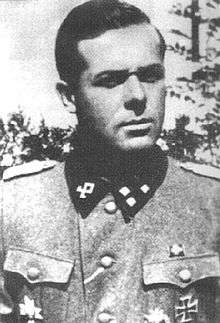Bernhard Dietsche
| Bernhard Dietsche | |
|---|---|
 | |
| Born |
3 February 1912 Singen, Germany |
| Died |
28 January 1975 (aged 62) Kaiserslautern, Germany |
| Allegiance |
|
| Service/branch |
|
| Years of service | 1934–45 |
| Rank | Obersturmbannführer |
| Unit |
SS-VT 7th SS Gebirgs Division Prinz Eugen |
| Battles/wars | World War II |
| Awards |
Knight's Cross of the Iron Cross Iron Cross 1st Class Iron Cross 2nd Class Infantry Assault Badge in Bronze Wound Badge in Gold Sudetenland Medal with Prague castle bar |
Bernhard Dietsche (3 February 1912 – 28 January 1975) was an Obersturmbannführer (Lieutenant Colonel) in the Waffen SS during World War II. He was awarded the Knight's Cross of the Iron Cross, which was awarded to recognize extreme battlefield bravery or successful military leadership by Nazi Germany during World War II.
Early life
Bernhard Dietsche was born on the 3 March 1912 in Singen in the south of Baden-Württemberg in southern Germany. He volunteered to join the SS-Verfügungstruppe (SS number 13.578) in 1934 and was then posted to the SS-Junkerschule in Bad Tölz as a lecturer in tactics, with the rank of Unterscharführer (Corporal). By 1936, he had been selected to become an officer and promoted to Standartenjunker (Officer Candidate). After graduation he was promoted to Untersturmführer (Second Lieutenant) in 1937 and was assigned to III./SS-VT-Standarte "Germania", Radolfzell, in 1938/39. He participated in the occupation of the Sudetenland in 1938, the annexation of Bohemia and Moravia on the 15 March 1939.
World War II
During World War II he was awarded the Iron Cross 2nd class during the Polish Campaign in October 1939 and the Iron Cross 1st class in June 1941, during Operation Barbarossa, the invasion of the Soviet Union.
He was awarded the Knight's Cross while in command of the II.Battalion, 2nd SS Gebirgsjäger Regiment, 7th SS Gebirgs Division Prinz Eugen, which was fighting against the partisans in Croatia and Serbia. It was awarded for his personal bravery and leadership of the Battalion.
Post war
Bernhard Dietsche survived the war and died in Kaiserslautern on the 28 January 1975.
Awards
- Knight's Cross of the Iron Cross on 17 July 1943 as SS-Sturmbannführer and commander of the II./SS-Gebirgsjäger-Regiment 2[1][Note 1]
Notes
References
Citations
Bibliography
- Fellgiebel, Walther-Peer (2000). Die Träger des Ritterkreuzes des Eisernen Kreuzes 1939–1945 — Die Inhaber der höchsten Auszeichnung des Zweiten Weltkrieges aller Wehrmachtteile [The Bearers of the Knight's Cross of the Iron Cross 1939–1945 — The Owners of the Highest Award of the Second World War of all Wehrmacht Branches] (in German). Friedberg, Germany: Podzun-Pallas. ISBN 978-3-7909-0284-6.
- Henschler, Henri; Fey, Willi (2003). Armor Battles of the Waffen-SS, 1943–45. Mechanicsburg, PA: Stackpole Books. ISBN 978-0-8117-2905-5.
- Mitcham, Samuel W (2007). Retreat to the Reich : the German defeat in France, 1944. Mechanicsburg, PA: Stackpole Books. ISBN 978-0-8117-3384-7.
- Mitcham, Samuel W (2007). The German Defeat in the East, 1944–45. Mechanicsburg, PA: Stackpole Books. ISBN 978-0-8117-3371-7.
- Scherzer, Veit (2007). Die Ritterkreuzträger 1939–1945 Die Inhaber des Ritterkreuzes des Eisernen Kreuzes 1939 von Heer, Luftwaffe, Kriegsmarine, Waffen-SS, Volkssturm sowie mit Deutschland verbündeter Streitkräfte nach den Unterlagen des Bundesarchives [The Knight's Cross Bearers 1939–1945 The Holders of the Knight's Cross of the Iron Cross 1939 by Army, Air Force, Navy, Waffen-SS, Volkssturm and Allied Forces with Germany According to the Documents of the Federal Archives] (in German). Jena, Germany: Scherzers Miltaer-Verlag. ISBN 978-3-938845-17-2.